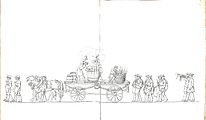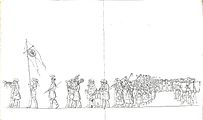Winemaker train
The winery procession is the name of a spring lithograph by Moritz Retzsch from 1840. It records the winery procession of the Saxon wine-growing society in the Lößnitz from 1840 . The painter and graphic artist Retzsch (1779–1857), who as a local winery owner was also the organizer of the move, made the graphic on eight sheets. The painter and graphic artist E. Otto (probably Retz's student Conrad Ernst Otto [1807–1847]) transferred the graphics onto the stone. The eight individual sheets were printed in the Dresden lithographic printing house Eduard Böhme, each folded in the middle and glued to the edge with the neighboring sheets to form a fan- fold ( folded out approx. 22 × 286 cm). This lithograph -Leporello with the black and white graphic was back in the Hofbuchdrucker CC Meinhold & Sons printed commemorative wine-growing company The wine festival of the wine-growing company in the Kingdom of Saxony on 25 October 1840 einmontiert and with it on 31 December of that Issued year.

The black and white prints by Retzsch shown here come from the copy of the Festschrift kept in the Radebeul City Archives , the Leporello of which has recently been restored. The in Scripture The Winzerzug of 1840. A tradition lives on by Birgit and Frank Andert shown colored lithographs come from the collection of the Saxon wine-growing museum in Hoflößnitz . That copy was colored by Käthe Bernhardt in 1958 and restored for the exhibition 850 Years of Viticulture in Saxony in 2011 . The copy is exhibited on the ground floor of the Hoflößnitz mountain and pleasure house .
The Leporello and its eight sheets
Motif description
The texts to be found in the column motif description below are the contemporary description of the vintner's procession in The Winzerfest der Weinbau-Gesellschaft in the Kingdom of Saxony on October 25, 1840 , the official publication of the organizer from the event year 1840. These are also included in the publication Der Winzerzug from 1840. A tradition lives on used by Birgit and Frank Andert from 2011 and assigned to the vintner procession and their themes.
| No. | leaf | theme | motive | Motif description | comment | image |
|---|---|---|---|---|---|---|
| 1 | 1 | Vintner as constable | Constable | "The procession began under the shooting of 50 vineyard cannons from the press yard of the Royal Hoflösnitzer vineyards in the following order: 1.) two winemakers as constables with heralds staffs;" |
The Presshof is the courtyard of the Hoflößnitz . It was the duty of the constables to maintain public order; at the start of the train they had to pave the way through the crowd as heralds. |
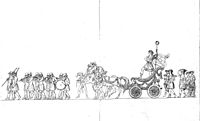
|
| 2 | 1 | Vintner as constable | Music choir | "2.) Music choir" |

|
|
| 3 | 1 | The autumn | Autumn as an allegory | “3.) the autumn in allegorical representation as the bringer of the festival in a red tunic with a yellow cloak, a wreath of autumn flowers on his head, a similar wreath on his ruler and standing on a triumphal chariot adorned with autumn flowers, the wheels interwoven with vines drawn by like-decorated horses, passed slowly and gravely; followed him " |

|
|
| 4th | 1 | The autumn | Girls with cornucopia | "4.) ideally dressed girls with cornucopia in their arms, baskets in their hands and on their heads, filled with all kinds of fruit;" | Cornucopia as mythological symbols for luck, but also fertility and wealth, are assigned to autumn as harvest time. |

|
| 5 | 2 | Bacchants | Fauns and Bacchantes | "5.) Fauns and Bacchantes, proclaiming the approach of Bacchus;" | Bacchants , participants in a cult celebration (orgy) of Dionysus. Including fauns or satyrs and Bacchantes or maenads |
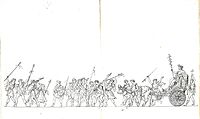
|
| 6th | 2 | Silenus and Fauns | Silenus and Fauns | "6.) Silenus, the tutor and companion of Bacchus, riding on a decorated donkey led by the fauns and supported by the fauns;" | Meant is Silenus , the leader of the choir of satyrs and Silenians |

|
| 7th | 2 | Bacchus and Fauns | Bacchus on a triumphal chariot | 7.) the god Bacchus in the noblest style, sitting high on a triumphal chariot adorned with vine tendrils, the wheels interwoven with vine tendrils, in his hand the Thyrsus stick and the head surrounded by a wreath of grapes, decorated and led bulls, their horns with bronze balls were adorned, drawn, fully clothed according to the myth, but depicted not in the picture of the boy, but of the handsome youth; " | Bacchus , the god of wine, here actually as the Greek Dionysus on his triumphal chariot, pulled by bulls (his animal form). In his hand the thyrsus staff as his symbol |

|
| 8th | 2 | Bacchus and Fauns | Fauns | "8.) some fauna," |

|
|
| 8a | 3 | Bacchus and Fauns | Fauns |

|
||
| 9 | 3 | Musicians | Music choir | "9.) a second music choir," |

|
|
| 10 | 3 | Standard bearer | Standard bearer | "10.) two Saxon flags carried by costumed winegrowers," |

|
|
| 11 | 3 | Standard bearer | Winemaker girl | "11.) two costumed vintner girls, carrying a large Assyrian grape (from the glass house of Frau Oberforstmeisterin von Bredow in Niederlößnitz) and a full vine tendril, both intended as a gift for JJ majesties the king and the queen," | The Bredows owned the later so-called Minckwitzsche Weinberg , on which sparkling wine had been produced since 1827 . On the estate there was a 40 m long greenhouse for growing grapes. The "Assyrian grape" was Portuguese muscatel . |

|
| 12 | 3 | Cupid on the barrel and blank wine cooper | Cupid on the barrel | 12.) a barrel of 1835 pure wine holding 6 buckets on a decorated wagon pulled by decorated horses led by costumed winemakers; enthroned on the barrel the little god of love missing at any festival, " | Blank wine: lat: vinum album, with Luther also: white wine . According to the bucket , the barrel held about 400 liters. |

|
| 13 | 3 | Cupid on the barrel and blank wine cooper | Blank wine cooper | "13.) Costumed cooper (from the Domanial main cellar in Dresden), the barrel of wine was crushed from the wagon into the festival hall by cooper of the main cellar with the skill peculiar to them;" |
Domanial: belonging to a domanium , i.e. the electoral chamber property. schroten (outdated): rolling, rolling or pushing heavy loads, from mhdt. : shot, probably to shot in its old meaning "tree trunk". |

|
| 13a | 4th | Cupid on the barrel and blank wine cooper | Blank wine cooper | The cooper makes wooden vessels. |

|
|
| 14th | 4th | Production of sparkling wines | Float | "14.) a wagon from the factory of sparkling wines from Niederlößnitz;" | The factory for sparkling wines, later the Bussard sparkling wine cellar , was the second oldest sparkling wine cellar in Germany. |

|
| 15th | 4th | Production of sparkling wines | Factory workers | “15.) A train of 12 factory workers, on the wagon […] was the boss de cave of the factory with his atlier consisting of 7 people, of whom the first opened the bottles in front of a large tin helmet and from the yeast and foam that spurted out cleaned, then handed it to fill up, from whose hands they came under the corking machine, [...] whereupon the bottle went to the next who tied it with string and then handed it to his neighbor, who fastened the wire until it finally got came to the chef de cave, who covered the cork and bottle neck with the tinfoil. These manipulations were also carried out during the procession, whereby the degorgeur often took breaks and, to the great amusement of the public, let the powerful gas hiss under the audience in fine jets. " |
The chef de cave shown here was the factory's first cellar master until 1848 , Johann Joseph Mouzon from Reims, who built up the production with bottle fermentation in the Champagne style. The degorgeur removed the yeast from the neck of the bottle. |

|
| 16 | 5 | Cooper and basket maker | Floats and craftsmen | “16.) a wagon with the workshop of the cooper and the basket maker, on which 2 master cooper and 1 basket maker (master cooper Müller from Kötzschenbroda and Findeisen in Oberlößnitz, basket maker Rasch in Niederlößnitz) were in full activity; the two coopers on the wagon of the cooper and basket maker fired and tied a new wine barrel of 6 buckets; a basket maker weaved a bottle basket; " |

|
|
| 17th | 5 | Cooper and basket maker | Music choir | "17.) a third music choir, this was followed by the vintner procession, consisting of" |

|
|
| 17a | 6th | Master winemaker of Saxony | Music choir |

|
||
| 18th | 6th | Master winemaker of Saxony | Standard bearer | "18.) a costumed winemaker boy, carrying the beautiful, stately flag of the winemaker;" |

|
|
| 19th | 6th | Master winemaker of Saxony | Miner as Paul Knohll | "19.) a miner, representing the first master winemaker in Saxony, Paul Knohll, who first introduced a rational wine culture in Saxony in the 17th century, in the costume of his time;" | Johann Paul Knohll , building and mountain clerk, 1667 author of the Klein Vinicultur booklet |

|
| 20th | 6th | Master winemaker of Saxony | Bergvoigte of the Domanial vineyards | "20.) the three mountain vaults of the Domanial vineyards, distinguished by their short sticks surrounded by vines;" | incumbent mountain bailiffs of the electoral vineyards in the Lößnitz, von Cossebaude and Pillnitz |

|
| 21st | 6th | Master winemaker of Saxony | Flatbed master | “21.) four plank masters with plank beds the vintner representing Paul Knohll sang the poem distributed to the vintner boys and given to the festival committee for this purpose by Pastor M. Jacobi in Reichenberg, the refrain of which was repeated by the next vintner boys and girls in the choir; " |
Platform master as a folder, the platform as a symbolic instrument of punishment |

|
| 22nd | 6th | Winemaker girls and boys | Winemaker girls and boys | "22.) several costumed, wreaths and tendrils adorned vintner boys and vintner girls in pairs, the former wine tines with vines wrapped around their shoulders, the latter carrying wreaths and sickles in their hands;" |

|
|
| 23 | 6th | Winemaker girls and boys | Winegrowers | "23.) Sixty vintner boys in costume, carrying wine butts painted green, filled with grapes and provided with red ribbons;" | Butter carriers were the workers who brought the grapes to the collecting barrel in a back container during the grape harvest . |

|
| 23a | 7th | Winemaker girls and boys | Winegrowers |
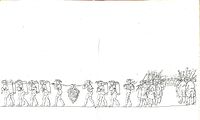
|
||
| 24 | 7th | Caleb's pigeon | Veal grape carrier | "24.) two costumed winegrowers, carrying the so-called caleb's grape hanging from a pressed tree on their shoulders;" | The veal bunch is tied together from many individual grapes and carried on the shoulders of two men. |

|
| 25th | 7th | Caleb's pigeon | Butter carrier | "25.) two costumed butterflies;" |

|
|
| 26th | 7th | Caleb's pigeon | Press ax carrier | "26.) a costumed winemaker, carrying the cleaver wrapped with vines;" | The Pressbeil served during pressing, to the outer regions of the pressed marc separate because these less pressure have been exposed. These parts were pressed further in a further pressing process. |

|
| 27 | 7th | Winemaker | Winemaker | "27.) many winemakers in pairs with different tools;" |

|
|
| 27a | 8th | Winemaker | Winemaker |
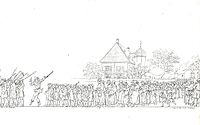
|
||
| 28 | 8th | Harlequin and Guardian Boy | harlequin | "28.) a funny person, provided with a cot and bell collar;" | Harlequin as master of ceremonies, the cot as a symbolic instrument of punishment |

|
| 29 | 8th | Harlequin and Guardian Boy | Guardian boy | “29.) Sixteen boys adorned with vine leaves and provided with watch horns; the 16 guard boys uttered a few tones through their differently shaped horns " |

|
|
| 30 31 |
8th | The people | Winemakers | "30.) many vintners and 31.) vintners in a long train." |

|
literature
-
The winegrowers' festival of the wine-growing society in the Kingdom of Saxony on October 25, 1840. Hofbuchdruckerei C. C. Meinhold and Sons, Dresden undated (1840).
- therein: Moritz Retzsch (Ill.), E. Otto (Litho.): Vintner procession. 8 sheets, glued to form a fan-fold. Eduard Böhme lithograph, Dresden undated (1840).
- Birgit Andert (text, ed.), Frank Andert (text, ed.), Moritz Retzsch (ill.): The winery procession of 1840. A tradition revives. Redaktions- und Verlagsgesellschaft Elbland, Meißen 2011.
Web links
- On the lithograph by Moritz Retzsch with the colored wine growers' procession from the Hoflößnitz in 16 pictures.
- Website on the modern Saxon wine grower train.
Individual evidence
- ↑ Birgit and Frank Andert: The winery procession of 1840. A tradition lives on. Meißen 2011, p. 50.
- ↑ Birgit and Frank Andert: The winery procession of 1840. A tradition lives on. Meißen 2011, p. 49.
- ^ According to information from the museum management of the Saxon Wine Museum Hoflößnitz from September 20, 2013.
- ↑ to grind. In: duden.de






